Does Fluorescence Cause Milkiness, Cloudy, Haziness Or Transparency Issues in Diamonds?
Yes it does.
You’ve read that right and these cases are NOT rare.
Time and time again, I have had people sending me emails asking me whether fluorescence in diamonds is a good or bad thing. Most of the time, they have heard that buying diamonds with fluorescence is recommended for lower colors and you won’t have any issues with undesirable appearances. Well, let me tell you this, the people who believe this only get half the equation correct.
Before we delve deeper into this topic, here’s an example of a diamond with an oily appearance as a result of ‘undesirable’ fluorescence.

Source: http://lgdl.gia.edu/pdfs/W97_fluoresce.pdf
There is a lot of misinformation on this topic. Many ‘so-called’ gurus say that medium, strong or very strong blue fluorescence won’t make a diamond look milky or take up an oily appearance and that even if it does, it is only in the exception of very rare cases.
And where does all these misinformation stem from? It goes all the way back to this report by GIA on a study performed with visual examinations. I strongly encourage you to download the study and read it yourself as we will be making regular references to this article. Some very contradictory statements were made and I believe many people who read the report were misled by the way the study was worded and explained.
The report itself is 16 pages long and admittedly, isn’t the most exciting paper most people would devote 1 or 2 hours of their time to. Because of this, I highly doubt that people guilty of spreading the misinformation had read through the entire study, fully understand it and thought about the results/findings in a critical manner.
Now, I come from a background in science and research where my previous job requires me to pour over statistics and read scientific journals all the time. Outside the laboratory, I am your typical geek who spends a lot of time studying and researching on specific topics. Unlike most people, I have a huge appetite for boring journals and can dissect information with the skills developed from my previous work experience.
For the record, here are the extracted sentences causing the misinformation.
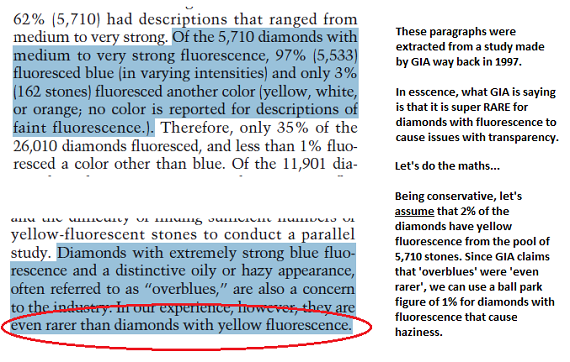
Without singling out any other online resources, whenever the topic of haziness or transparency in relation to fluorescence is brought up, this GIA study would usually be quoted.
Along with it usually follows bad advice that the consumer won’t have to worry about any cloudiness or undesirable appearances of a diamond with medium or strong fluorescence.
Seriously? Have They Looked at the Tabulated Findings And Results?
Let me attempt to explain the study in plain English. I am limiting my scope on the portion of fluorescence and its impact on transparency.
Basically, a group of observers from the industry (majority) and general public viewed 4 colored sets of diamonds (E, G, I, and K) with varying degrees of fluorescence under 5 different lighting conditions. They were then required to fill up a questionnaire based on their observations.
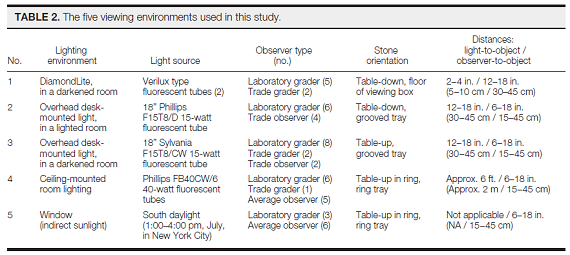
As you soon as you start to break down the results of the experiments, many unanswered questions and inconsistencies begin to surface.

If fluorescence had NO EFFECT or whatsoever on the transparency of the diamonds as claimed by GIA, why did 50% of the observers (indicated by the red arrow) say that there is a perceived difference being noted?
Next, if fluorescent diamonds with milky appearances are indeed so rare, what accounted for the huge amount of observations that medium/strong/very strong fluorescence was observed to be ‘least transparent’?
I am not making this up. Verify this against the diagrams in the study yourself.
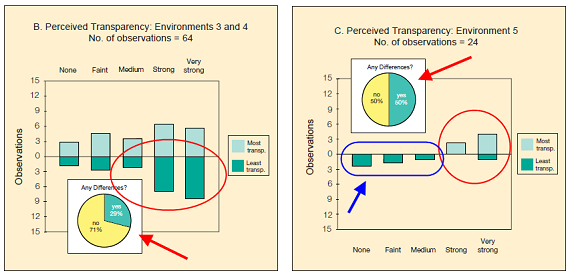
Looking at the results for experiment 3 and 4, the same questions above are raised again. Why did so many people report noticing differences amongst the diamonds? If it is merely a negligible percentage of super rare diamonds that causes this issue, why would the experimental results disagree with the claim?
In the last environment condition (5) which was conducted under indirect sunlight, 50% of observers noted something going on with the diamonds when viewed beside the window in daylight.
On first glance, you might probably wonder: “Isn’t a diamond with NO fluorescence (circled in blue) supposed to have no effects on transparency?” Why did 3 out of 24 people (12.5%) say these diamonds were the least transparent?
On the contrary, this corresponded to people who observed that strong/very strong fluorescence (circled in red) actually made the diamonds clearer than they are. Since the comparison in transparency is relative, this result comes as no surprise.
But That’s Not Saying Anything Conclusive About Fluorescence!
From this experimental finding, it might appear that fluorescence actually helps the diamonds look transparent! What a paradox. However, the sample size is way too small for any meaningful conclusions.
To put in simple words, you can ignore the findings from experiment 5 except for the fact that 50% of the observers in this test noticed differences in transparency between the diamonds. To be fair, GIA did mention that more research was needed to look into this.
Be it good or bad, the above results all seem to indicate that fluorescence has an impact on the diamonds’ appearance.
I worked as a research officer in a top government research institute in my previous job. During that time, I had penned and published several scientific papers in respectable journals. Whenever I see statistics and anomalies like this, it immediately brings the entire experiment under scrutiny.
Concrete explanations about findings are clearly lacking and nowhere to be found. In the scientific community, you will NEVER get away with contradicting results without any sound explanations in a report. This will undoubtedly cause your paper to be rejected by the reviewer.
To Put the Icing on the Cake…
Based on NON-CONCLUSIVE results, guess what happened in the summary of the paper?

Even though the experiments clearly showed conflicting outcomes from a small sample size of observers, GIA simply ignored the results and came to the conclusion that everything was “fine”.
Screw the Study, Use Your Own Eyes to Determine Cloudiness
“First, we try to impress people with nice figures and numbers that diamond fluorescence will NOT have an impact on transparency except for super rare cases.
Oh, the results are telling us a different thing? Never mind, let’s just hope no one will notice and ask questions.
Then we say that it might actually help improve transparency.
But hey, we are not sure and require more studies. Oh no… We just shot ourselves in the legs. Oh boy, what a mess… But we really need to stand by what we said earlier.
Ok, since we can’t convince them (or ourselves), let’s just try to confuse everyone.”
Damn… You Just Can’t Make Up Your Mind…
Don’t get me wrong here; the study is still valid to some extent. I can agree with the results that were shown on the perceived colors of diamonds. GIA had gone to great lengths and details to explain their results and findings on that aspect.
However, when it comes to perceived transparency, things aren’t quite right there. To start by claiming that diamonds with undesirable fluorescence effects are SUPER RARE and contradict it later in the results doesn’t help the readers at all.
Based on my own observations of viewing diamonds physically, let me tell you that diamonds with medium – strong – very strong blue fluorescence impacting a diamond’s transparency are much more common than you think it is.
Here’s where people and even jewelers themselves get confused because they never ASK questions and simply accept what is thrown to them!
The degree of haziness doesn’t necessarily have to show itself to be as severe as the example found at the beginning of this article. Such extreme cases are what GIA termed as rare and based on the study, they only seem to consider such stones and excluded the rest with less degrees of haziness!
You see the point I am getting here? In the study that GIA conducted, 30% of the observations concluded that the transparency of the diamonds was impacted. Here’s my take, because these diamonds didn’t appear to be “super oily”, these stones were wrongly classified by the researchers to exhibit no haziness at all. Gosh…
The best analogy here is eating a packet of potato chips with 80% reduced fat. Just because the chips had lesser fats don’t mean the chips didn’t have fats! Likewise, just because the diamonds didn’t exhibit an extreme haziness effect doesn’t mean they didn’t exhibit slight haziness effects.
Here’s My Personal Observation And Guidelines
Brian Gavin’s Blue diamonds are handpicked for performance.
In my opinion, it is definitely NOT SUPER RARE as claimed by GIA in their study. In fact, they published another article titled “About Fluorescence” in recent times stating that “fewer than 0.2% of the fluorescent diamonds submitted to GIA exhibit this effect”. Geez…
- Generally speaking, diamonds in the colorless category D-F have a greater chance of being hazy when coupled with medium or v/strong fluorescence.
- Haziness issues usually arise when we move towards a spectrum of more intense blue fluorescence. With that said, don’t be afraid of buying diamonds with strong or very strong fluorescence. The point here is to avoid buying blind. Either have a trustworthy gemologist help you review the stone or physically see the diamond before laying down your cash.
- Faint fluorescence usually doesn’t impact the diamond’s look in any manner. In higher color grades like D-F, there is usually no difference in appearance. In lower color grades, faint fluorescence won’t help you much in making the stone look ‘whiter’.
On a side note, I personally love fluorescence and it is really a matter of individual preferences. What you need to take back here is to exercise due caution when making a purchase. You don’t want to end up with a hazy diamond that costs you thousands of dollars.
With proper selection techniques, you can enjoy significantly lower prices and Brian Gavin is one of the best places to shop for fluorescent diamonds. On the next page, I’ll show you how prices vary across diamonds with different fluorescence properties.
Related Articles
Leave A Comment


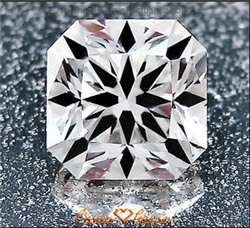


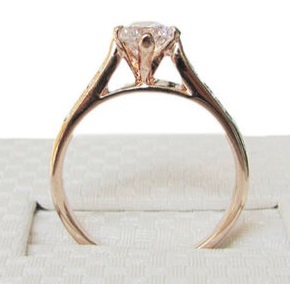









30 Comments
Hi.. thanks for the article. what about https://www.jamesallen.com/loose-diamonds/princess-cut/1.21-carat-i-color-vs1-clarity-sku-858062
Does this diamond have haziness because of the strong florescence?
It doesn’t look cloudy. Fluorescence isn’t the issue here. Cut is. This princess cut diamond has a flat crown and excessively large table. Fire is going to be negatively impacted.
Isn’t it true that man new made diamonds are so hard to distinguish from real one that they only can be separated by fluorescence? Do man made diamonds have strong fluorescence?
It depends. Not all synthetic stones have fluorescence. Also, fluorescence isn’t the method used by labs to identify man made stones.
You can read these links for more details:
https://www.gia.edu/gia-news-research-improved-quality-identification-challenges
http://d.neadiamonds.com/identify-a-created-diamond
Hi!! Thank you so much for creating this website!! So informative and easy to understand. I’m in the process of upgrading my current 2.3 european cut k color ring and am considering this one on James Allen. https://www.jamesallen.com/loose-diamonds/round-cut/4.04-carat-i-color-vs1-clarity-excellent-cut-sku-966470
I have done the chat and compared it to two other stones and their diamond expert recommended this one. However I thought it looked a little hazy and dark maybe due to the medium fluorescence?
The diamond doesn’t look hazy. Here’s an example of one to give you some idea on how it appears: https://beyond4cs.com/go/ja-453616/
Fluorescence is not the issue with the diamond you picked. Cut quality is. It isn’t well cut enough.
Hi Paul,
Thanks for the great website, it has been a great source for me on the process of choosing my ring.
I still find quite difficult to identify the hazy effect on diamonds with fluorescence. Do these look hazy to you?
Diamond 1)
https://www.jamesallen.com/loose-diamonds/marquise-cut/0.81-carat-i-color-vs2-clarity-sku-2020996
Diamond 2)
https://www.jamesallen.com/loose-diamonds/marquise-cut/0.75-carat-g-color-vvs1-clarity-sku-1766131
Both diamonds don’t have issues with cloudiness. Also, I think you did your research really well. Both are fantastically cut for light performance. I do think the G VVS1 diamond is the slightly better cut option between the 2.
Hi Paul,
What is you opinion on this one:
https://www.jamesallen.com/loose-diamonds/round-cut/1.02-carat-h-color-vs2-clarity-excellent-cut-sku-2091151
It has medium fluor, does it look cloudy?
Thank you for the Great website!
Alexey
The diamond isn’t cloudy looking.
Hi Paul,
Thanks so much for your website. I’m looking for an approximately 2 carat ring, color D-F, clarity VS1 and above, excellent cut from GIA, with a budget of $25,000 for the stone. Most of the diamonds within my budget have strong fluorescence. Will it be obvious to me from the videos/pictures if the diamond has signs of haziness due to blue fluorescence? For example, I can’t see any sign of haziness in the below diamond but I’m not sure if I’m just missing it. Thanks!
https://www.jamesallen.com/loose-diamonds/round-cut/2.01-carat-f-color-vs1-clarity-excellent-cut-sku-2183173
Alexis
From the video, fluorescence doesn’t seem to be causing an issue in haziness. To be on the safe side, I would suggest getting James Allen to eyeball the stone prior to making a purchase. They should be able to give you a clear answer to the diamond’s transparency.
Thanks for the information. I am looking at the following two diamonds. Any information on whether they look cloudy or any other comments you have would be helpful. I am looking for one that has very good light performance.
http://www.briangavindiamonds.com/diamonds/diamond-details/1.595-g-vs1-round-diamond-ags-bl-104087126005
and this
http://www.briangavindiamonds.com/diamonds/diamond-details/1.660-g-vs1-round-diamond-ags-bl-104087126003
Thanks
Rest assured that both diamonds are not hazy or cloudy in anyway. In fact, they are top notch diamonds with superb cut quality.
This article is going to interest you: https://beyond4cs.com/reviews/brian-gavin-diamonds/blue/
This is my personal pick as it offers better value for money: http://www.briangavindiamonds.com/diamonds/diamond-details/1.660-g-vs1-round-diamond-ags-bl-104087126003
Thank you so much for this article! I have been doing a lot of research and there is so much conflicting information out there. I have found a diamond online that I really like but I am worried about the fluorescence, which is listed as Strong Blue. It does not look cloudy to my untrained eye but I could perhaps be missing something.
https://www.jamesallen.com/loose-diamonds/round-cut/1.43-carat-i-color-vvs2-clarity-excellent-cut-sku-3747618
If you could offer your opinion, I would be very grateful.
There’s conflicting information because fluorescence depends on a case by case basis. In the diamond you linked above, the stone isn’t hazy or cloudy.
Hello,
Would really appreciate your feed back.
https://www.jamesallen.com/loose-diamonds/round-cut/2.00-carat-g-color-vs2-clarity-excellent-cut-sku-4553089
https://www.jamesallen.com/loose-diamonds/round-cut/2.41-carat-d-color-vs2-clarity-excellent-cut-sku-4637830
Comparing these two diamonds I know the 2 karat is a really quality but for a little more I can buy a 2.4. But my concern is the crystals and the medium flourescence on the GIA report I heard that I should avoid crystals around the table although it is a vs2 – some people reported still seeing black crystals even if it was a vs2. I also heard that better cut diamonds may actually look bigger although I don’t think it would look as big as a 2.4k.
I know we are comparing two huge differences in karat size but do u think the quality of 2.4 is worth the extra cost?
Clarity isn’t your issue. I would say that both diamonds are eyeclean. The D diamond isn’t as well cut as the G diamond. And since I prioritize cut above anything else, I do have preference for the 1st option above.
Hi Paul,
I’m going to a jeweler to view some strong blue fluorescent diamonds.
As a general rule, what should I be doing to assess these diamonds? Which lighting conditions would exhibit milkiness/haziness/oiliness if there was any? Should I ask to view the diamond under a blacklight to see the degree of fluorescence?
Look at the stone in diffused lighting and if it were hazy, it shows up readily. What’s your purpose of viewing the diamond under black light and checking for intensity? It’s not as if you are going to grade it better than the professional graders who do it for a living (assuming it is a stone by GIA).
The question about asking to see the diamond under a blacklight is only because I’m actually quite fond of the fluorescence and would like to see how it looks when fluorescing. It’s purely to satisfy my curiosity, not to try and validate the grading.
Do jewelers normally have this kind of lighting available? Should I bring my own?
I’ve been given a lot of advice to never purchase a strong fluorescence diamond “sight unseen”. Would any haziness be evident in the HD photos provided from online diamond vendors? Would a clean looking HD photo of the diamond be sufficient inspection to purchase a strong fluorescent diamond in your opinion?
It depends. Most jewelers should have a black light “torch” that would enable you to see the blue fluorescence being activated. It doesn’t hurt to bring your own light source.
When diamonds are hazy due to fluorescence, it’s really obvious. A video will reveal such issues easily. With the better vendors, hazy diamonds don’t even get into their inventory in the first place as they curate them for such issues. Brian Gavin is one fine example of a specialist dealing with ideal cut diamonds with blue fluorescence. You will Never see a single hazy stone in their inventory.
Hi Paul. I would like to purchase an Art Deco emerald cut solitaire ring. Aprox 6 cts, measures 12.37mm x 9.04mm x 5.87mm, assessed color K with clarity of VVS with further baguette cut diamonds to shoulders, platinum mount weighs 5.7 grams, overall good, minor wear. They want 36,000 US. They state it has medium blue florescence which actually makes the diamond look better. Is that a good price?
Thank you,
Len
Well, fluorescence should be the least of your worries. You seem to be getting yourself into a big rip off. First of all, who graded the diamond ring? And from what you told me, with approximation, it doesn’t bode well. I can tell that it isn’t going to be graded by GIA or AGS and you are likely buying an uncertified diamond and that’s really dangerous.
Hi Paul,
Thanks a lot for your website, it’s been really useful as a first time diamond buyer. Hopefully I’ve managed to get some things right when choosing..
I would really appreciate your thoughts on the following strong blue diamond in regards to haziness. During the chat with a couple different agents, their thoughts were it showed no signs of haziness based on the HD video, so I purchased it and requested the idealscope image (as it wasnt on file) before proceeding with the ring production.
The gemologist provided the idealscope image and added the following comment:
“The diamond is a true F color and faces up white. The overall brilliance and light performance is excellent and the diamond has bright light return with balanced pattern/scintillation. The fire/sparkle is very good and this is an eye clean diamond. Strong blue fluorescence gives the stone a very slight haze.”
My concern is with the slight haze. Will this be more obvious in daylight and affect the brilliance? Or is it more likely that it really is just a very slight haze and I shouldn’t worry?
https://www.jamesallen.com/loose-diamonds/round-cut/0.63-carat-f-color-si1-clarity-excellent-cut-sku-6831668
Thanks in advance!
This diamond should have a very strong idealscope image that indicates strong light return. I looked at the diamond listing and the diamond doesn’t look hazy in the video. Having said that, if the gemologist inspected the diamond and says that the haze effect is very slight, it might not be noticeable to you or could only have the haziness show up in certain lighting. The best course of action is to look at the ring in person and see if you like it. If you do, keep the ring. If you don’t, send it back for a no questions refund. James Allen is good that way.
Hi Paul,
I’m looking for a nice engagement ring for my (hopefully) soon-to-be fiance and throughout the process I always came back to your site to improve my knowledge. Really comprehensive information, you did a tremendous job!
This is one of the stones that I consider buying:
https://www.bluenile.com/uk/build-your-own-ring/diamond-details/LD11340052
I was intrigued by its top-performing brilliance, fire & sparkle characteristics in the GemEx report. It also has nice proportions according to your “princess chart”. My priorities would be size and appearance, so I chose one with a lower clarity & color grading, in favor of size and cut. Color should be less noticeable since its a princess cut (I got that from you) I just don’t want it to be hazy. Although Blue Nile don’t have high-res videos like James Allen, it still looks good in my amateurish eyes, but I would love to hear the expert’s opinion :) By the way, I don’t mind the strong blue fluorescence, I even think it might be a cool “feature”.
I reviewed the diamond and I think that the diamond doesn’t look hazy. If it is, you would be able to pick up the cloudiness in the diamond easily. The diamond is also well cut for light performance and I think it is a good choice to get value for money. Go for it!
Yes, Paul! On my way, lol! You’ve been a tremendous help and I now probably know more about diamonds than a lot of “staff” at some jewelry store retailers, thanks to this site! Have a great day!
Fluorescence does not cause haziness. It are two different structures in a diamond that cause both phenonems.
Fluorescence is caused by N3 aggregates, but becomes only visible when enough A-agregates are transformed into B-agregates.
Haziness is caused by platelets that grow to a size that interferes with light. But platelets grow in size with the formation of B-agregates.
So the cause of appearing for both is the formation of B-agregates, but fluorescense itself is not creating the haziness. That is the reason that not all strong fluorescing stones look hazy.